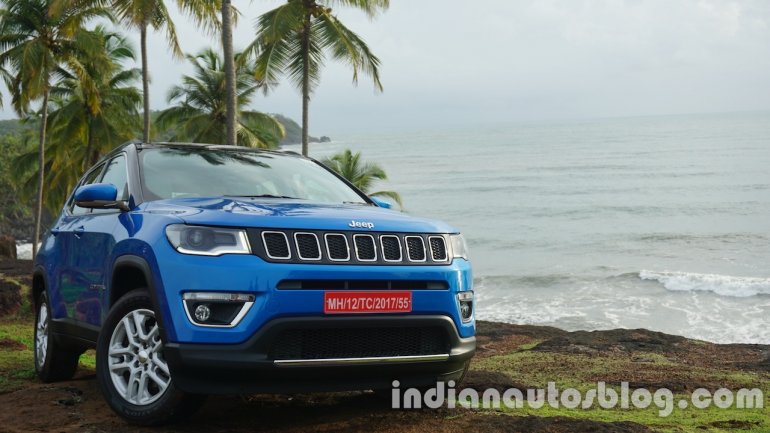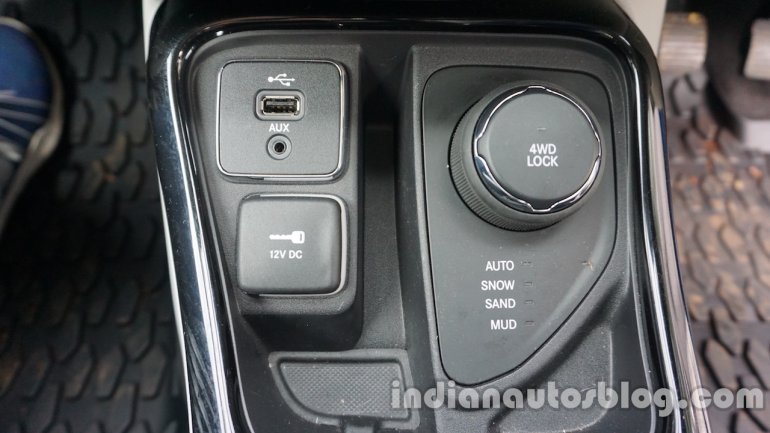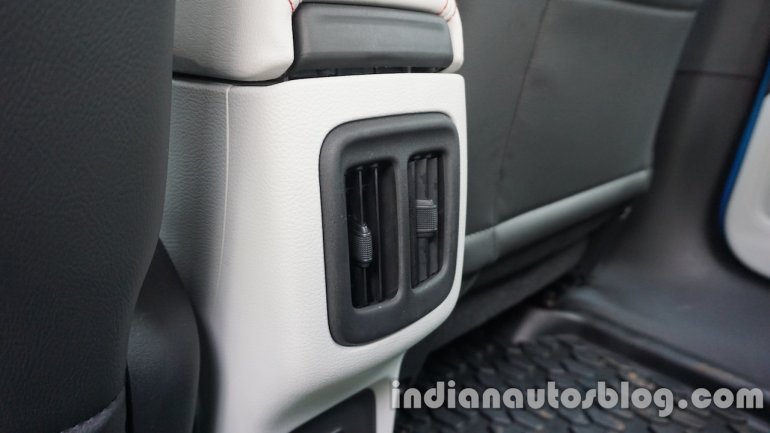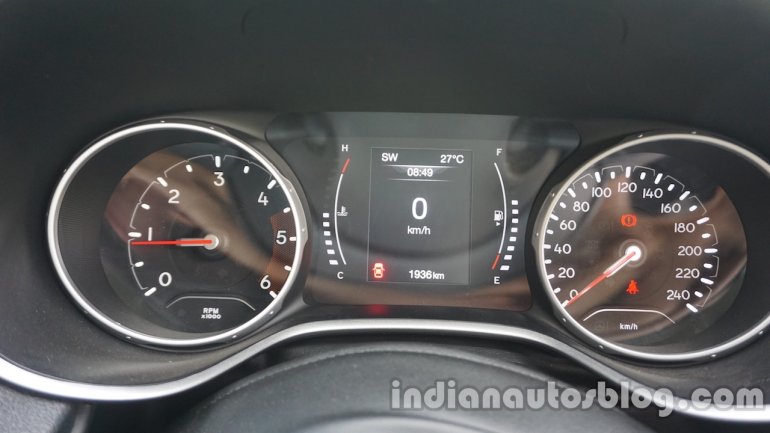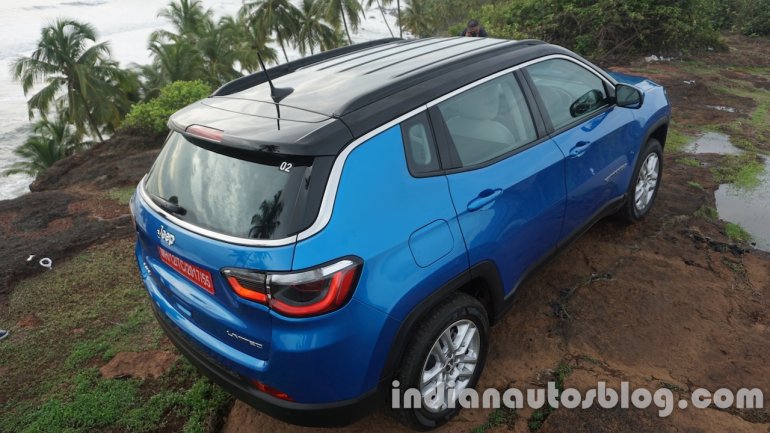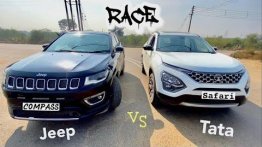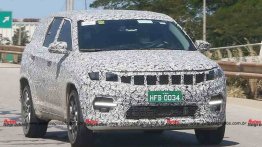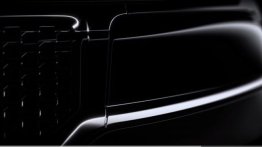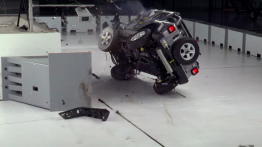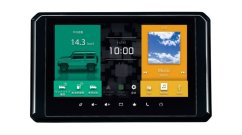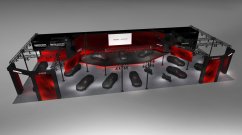The Compass is Jeep’s third offering in India after it entered the country just last year. The first two launches were the Grand Cherokee (starting at 94 lakh ex-showroom) and the Wrangler (starting at 56.5 lakh ex-showroom). Both these nameplates hold legendary status, not unlike the Jeep brand, and their very launch in the country was a way to introduce the brand on our shores. Now the term Jeep isn’t new to India in itself.
For three-quarters of a century we have associated the word with Mahindra, and there is good reason for that. Both, Jeep and Mahindra, were born around the same time, and Mahindra bought the license to produce Jeeps in India during the independence era. So, in more ways than one, Jeep contributed to the rise of Mahindra and both have shared a common DNA since; one that revolved around off-road utility and the seven slat front grill. The similarities however, end right there.
What Mahindra became to India, Jeep has been to America, and I reckon the Jeep dealer in India will have to spend some time ejecting the Mahindra connection to the term Jeep from the buyer’s mind and re-incepting it to identify the company it originally belongs to.
What is the Compass?
The Compass is a compact crossover pointed straight at the Indian mass market (well, relatively), and one that would possibly rival the Hyundai Tucson and Innova Crysta with an expected sticker price of 18 to 25 lakh ex-showroom. It already starts out with a few disadvantages: it is smaller (4395 x 1818 x 1640 mm) than its peers, doesn’t match up to the equipment list offered on the competition, and the dealer network in the country remains scarce. But despite that, it has enough tricks up its sleeve to warrant serious consideration and we will look at them in depth.
Exterior
The Compass holds an imposing stance that invites attention out on the road. The design is a derivative of the larger Grand Cherokee, and is unmistakably Jeep. At the front, the 7-slat all-black grill remains standard irrespective of the colour you choose for the car. It is superimposed on either sides by the bi-xenon headlamps that hold impressive day time running LEDs inside a thick white plastic cladding that underline the HIDs. The bumper integrates very bright rectangular fog lamps, a pair of cornering lamps, and is underscored by a nice and thick chrome strip that adds to the attractiveness of the design.
Further to the sides, you will notice the distinctly trapezoidal wheel arches, which are a staple of Jeep identification, and for some reason, a rear axle that doesn’t sit on the central axis of the wheel arch. A thick chrome line emanates out of the side mirror, travels along the roof line, ducks into the wildly thick D-pillar, goes around the rear of the car underlining the windshield, and follows an identical path to the side mirror on the other side - very nicely done. A similar trajectory is followed by the thick plastic cladding that runs around the lower part of the car to protect the body from when you point the Compass off the road.
When you do point the Compass off the road, the 17 degree approach and 32 degree departure angles are enough to gallop up and down most hills. And for steeper inclines, it is a way to restrict the driver from attempting them. Overall, the Compass comes off as a very well designed sports utility that looks bigger than it actually is in-person, holds onto clean and sedate lines that make it feel right at home in the jungle.
Interior
As per early reports, Jeep is going to offer the Compass in a choice of three interior colours: all-black, beige, and a bright white that Jeep has tagged 'Ski Grey’. The three variants on offer include Sport, Longitude and Limited. Optional packs on each variant aren’t ruled out either since Jeep intends to offer a high degree of customisation on launch. We drove the top spec Limited variant with the Ski Grey interior. While on first impressions, it does come off as a rich cabin colour, it is going to be a pain to maintain. Dirt and stains are going to be evident and buyers will have to treat the leather with care. That said, the contrast red stitching on the seats is a nice touch and makes the cabin feel expensive.
The Compass can host five people at a time and said people are surrounded by leather, chrome, and soft touch plastics. The interior design language is sedate with not too much happening, which is a good thing. Lines, curves and contours have some relevant design sense hanging in the backdrop.The Compass’ inside is a good place to be. It is comfortable for all its occupants even if they are north of six feet tall. There is enough leg and head room to go around. Rear air-conditioning vents are included though they lack their own controls. Powered seats are conspicuous by their absence through the cabin.
The magnesium steering wheel is very bold and nicely covered in leather with add-on chrome and silver accents. It holds buttons for audio and telephony on the left and a bundle of dummy buttons on the right, covering the space where the cruise control buttons would have been, had the feature been on offer in India. The dummy buttons look glaringly cheap and even the actual buttons have some play in them, which isn’t acceptable for the segment the Compass is targeting.
Realising that practically everybody today uses USB chargers for their phones, the Compass comes equipped with USB ports instead of 12V sockets at the front and rear of the car. A single 12V socket is still provided just in case. Storage inside the Compass is compact. Door pockets can hold 500ml bottles, the glovebox is not too deep, the armrest console too is restricted, and the boot is limited to around 400 litres. Good legroom does come at a price. However, second row seats do fall flat to open up more luggage space; but where do you put the children then?
Is the Compass a highway machine? It very much is, but if you travel people heavy, keep the luggage light.
Chrome and silver accents surround pretty much everything from the buttons, air-con vents and gear lever to the door handles and speakers. The gear shift is finished into an aluminium sphere that looks gorgeous but can be slippery to use during enthusiastic drives. Overall, the interior is well built and put together.
Infotainment
The Compass will come equipped with a 5” or 7” UConnect touchscreen infotainment system depending on the variant you choose. The Limited variant we have been driving around Goa came equipped with the larger 7” version paired to 6 speakers, which included a subwoofer sitting inside the dashboard. The audio quality is average and serious audiophiles may choose to upgrade it later.
Navigation is not included but thanks to CarPlay/ Android Auto, you can mirror Google Maps straight onto the 7” screen, which frankly is just way better than any other navigation software out there. Audio controls are included on the steering wheel as well as behind it and the UConnect menu also carries options for the climate control.
And, it does have a compass!
Engine and Transmission
MultiJet is not new to India. In fact, it is the most popular engine sold in the country as it underpins virtually all Maruti and Tata diesel vehicles. It comes from the Fiat Chrysler Automobiles (FCA) family and since FCA owns Jeep, MultiJet has made its way into the engine bay of the Compass as well, albeit in a much more powerful form. The 4 cylinder diesel MultiJet inside the Compass will displace 2.0 litres and produce 170 HP of power at 3750 rpm. 350 Nm of torque will be generated between 1750 & 2500 rpm.
On the petrol side of things, Jeep is introducing MultiAir under the hood of the Compass. It is an engine technology developed by Chrysler that allows for each cylinder to have its own valve timing, which boosts power by 10% and improves fuel economy. The MultiAir won the 'International Engine of the Year' award back in 2010. The 1.4 litre MultiAir 4 cylinder power plant on the Compass will produce 160 HP and 250 Nm of torque.
For transmission duties, Jeep will offer a 6 speed manual option on both, the diesel and the petrol, and an exclusive 7 speed dual clutch automatic on the petrol. The Compass will be available in two avatars: 4x2 and 4x4. The 4x4 option will be an All Wheel Drive (AWD) (also called Jeep Active Drive) variant that will deliver power to the front axle under normal conditions and quickly, under 300 milli seconds, shift over to 4x4 when the situation demands.
A '4WD Lock’ button on the central console will lock the transmission into 4WD permanently until unlocked by the driver. And depending on the terrain, the driver can choose, via a toggle switch, between Auto, Snow, Sand and Mud as terrain options, which will alter the Compass’ driving characteristics and various onboard systems to get through whatever it is pointed at, successfully.
Performance and Driving Impressions
We drove the 2.0L MultiJet diesel paired with a 6 speed manual transmission around Goa’s winding roads and tested the AWD artillery in the Goan wilderness. At the outset, we came back very impressed. The car gobbles up potholes, undulations, and just really poor roads with equal parts of zest and aplomb. It comes equipped with a Frequency Selective Damping (FSD) suspension, a Formula 1 derived technology that uses a set of valves to control low and high frequency inputs to the suspension and soften them as per the driving conditions. Or in other words, bad roads are made to feel soft, and in the case of no roads / soft surfaces like mud and snow are made to feel distinct.
The Compass handles beautifully out on the road and is well mannered around swift turns too. In the event of an understeer or oversteer occurring, a separate motor adds/subtracts steering torque to control the car’s behaviour automatically, so if you come out of it safe and sound, don’t be smug about it - maybe the car did it.
Coming to the engine itself, the MultiJet loves to be in the 1800 to 3000 rpm power band. Anything beyond that and the engine loses steam while continuing to be very throaty. It simply lacks the grunt higher up the rpm levels and that makes it feel less than the 170 HP advertised. The 6 speed manual is an able gearbox, slick to use, but an automatic option would have been better. India is quickly becoming a traffic heavy country and the lack of an automatic option on the diesel is going to hurt sales. The petrol will get the dual clutch automatic option but we haven’t yet had a chance to test it.
We did point the Compass in the direction of an off-road track and it performed ably to get through a lot of slush, mud and water. It is no Grand Cherokee or the mighty Wrangler, but it is from the same family. The performance off-the-road is impressive for a car this size and it will surprise if you do get an opportunity to beat it around the wilderness a bit. It does lack hill descent control and is more stall-friendly than crawl-friendly on first gear, which makes it vital for you to be accurate with pedal control while off-roading.
Jeep hasn’t released official ARAI fuel economy figures for the Compass. In fact, the petrol engines haven’t even made it to the roads yet. But expect the MultiJet diesels to have class leading fuel economy figures. That’s one thing they are well known for.
Features and Safety
Features onboard the Compass include Bi-Xenon HID headlamps, cornering fog lamps, daytime running lights, engine start-stop button, rear view camera with steering guides, and a cap-less fuel filler that protects against fuel spills. On the safety front, the usual additions include ABS with EBD, ESC, traction control, 6 airbags, ISOFIX seats, electronic roll mitigation, and hill start assist.
If the Compass is priced straight inline with the likes of the Hyundai Tucson, expect the Hyundai salesman to take the Compass for a ride. Compared to the Korean offering, the American Jeep feels scarcely done up. It does not feature powered seats, automatic headlamps or wipers or dimming IRVMs. There is no cruise control or LED headlamps. What the Compass does have exclusively is its 4x4 artillery and an electric parking brake that is standard across all variants.
Verdict
The Jeep Compass has undergone over 25.7 million kilometres of on and off road testing, which is enough to circumnavigate the Earth 640 times. It is well designed and built right here in India. It comes mated to good petrol and diesel engine options, and drives like a charm. It isn’t a “soft roader” by any means and can hold its own in tricky situations. It has enough equipment and feature levels to fulfil your transportation needs but when compared to the expected competition, falls woefully short, and this is what makes it tough to arrive at a verdict for the car, without a clear picture on pricing.
That said, cost consciousness is visible on the Compass. The rear air-con vents and speakers don’t get the same silver accents as the front ones do. The same is true for the buttons that aren’t in the line of sight of the driver. Aggressive pricing is expected from Jeep India, but how aggressive? It is expected to start at 18 lakh ex-showroom for the base variant, which would still place it at a 22 lakh on-road price point. If early reports are to be believed, the base Sport variant will carry steel wheels, a 5” touchscreen and halogen headlamps on a curtailed features list. Would it justify the 22 lakh sticker price?
The lack of an automatic option on the diesel is going to put off some customers in a segment that isn’t high volume to begin with. So, for the Compass to succeed, Jeep India will have to shock the market into submission with the price and pull off a marketing campaign that will fill its showrooms. It isn’t going to be easy but then again, when has a Jeep shied away from challenging terrain?
Specification
Dimension
- Length: 4.39m
- Width: 1.81m
- Height: 1.64m
- Wheelbase: 2.63m
- Approach Angle: 17 deg
- Departure Angle: 32 deg
- Boot: 408 litre
- cd: 0.35
Diesel: 2.0 MultiJet II
- Transmission: 6 MT
- Power: 170 HP @ 3750
- Torque: 350 Nm @ 1750-2500
Petrol: 1.4 MultiAir
- Transmission: 6 MT / 7 DDCT
- Power: 160 HP
- Torque: 250 Nm
Equipment
- 4x2 & 4x4
- Jeep Active Drive with Driveline Disconnect Technology with 4WD Lock
- Selec -Terrain (Auto/ Sand/ Snow/ Mud)
- Frequency Selective Damping Suspension
- Electric Parking Brake
- Tyres: Firestone 225/60 R17
Features
- Cornering Fog Lamps
- LED Tail Lamps
- Bi-Xenon HID Headlamps
- DRLs
- Dual Zone A/c
- Operation Buttons on Steering Wheel Backside
- 3.5” Driver Information Display
- Ski-Grey McKinley Leather Upholstery with Red Contrast Stitching
- Leather Wrapped Magnesium Steering Wheel
- Cap-less Fuel Filler Door
- Engine Start-Stop Button
- Rear Camera with Guidelines
- Compass
Safety
- Dynamic Steering Torque
- 6 Air Bags
- TCS
- ESC
- ABS, EBD
- ISOFIX
- Electronic Roll Mitigation
- Hill Start Assist
- Electronic Brake Pre-Fill
- Hydraulic Boost Failure Compensation (HBFC)
Infotainment
- 7” UConnect 4 Touchscreen Infotainment
- Voice Command
- Bluetooth Audio
- Android Auto + Apple Car Play
- 6 Speakers
